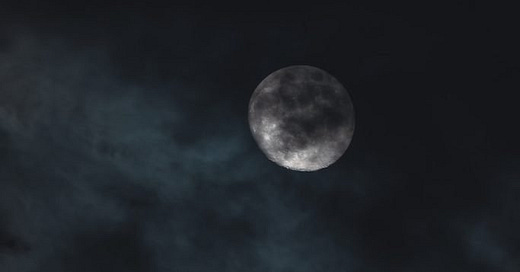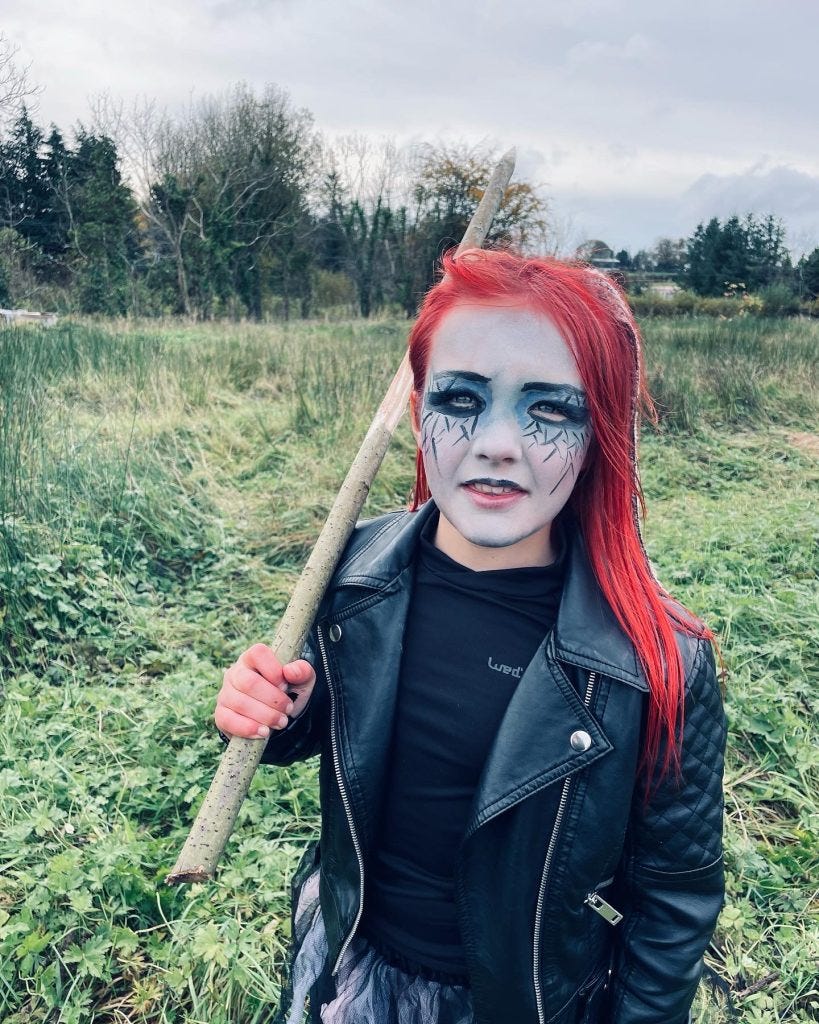A Hymn for Samhain
We position ourselves on the spruce-lined avenue: the children hunker at the base of a tree, I press my back against another, my husband straddles the edge of parkland and forest. He begins to squeak into the palm of his hand, the high-pitched kissing of a rabbit in distress. We face east, away from the setting sun. Bats streak past, curious, on the hunt. We hold our position as the minutes pass. I can make out the twitching body of my youngest, eager to do battle with the shadows. Then, just as we grow weary of squeaking and waiting, I spot the slow, silent sweep of owl. I hear the collective intake of my children’s breath and we strain into the dusk to watch her alight on a branch. My husband intensifies his squeaks, owl takes to the wing and settles in the tree above his head. She is swallowed by darkness, lost to sight, but knowing she is there is enough.
//
Owl, crone of the night, gatekeeper of the gloaming, you have intrigued me since childhood.
//
Probing the Darkness
Halloween can be a divisive celebration. When I was growing up, we did not engage with the skeletons or witches. There was a little apple bobbing, a sparkler or two and a tart full of hidden coins, but we drew the line at death. I understand the reasoning, but I wonder if I might probe the darkness a little and see what we can find?
Samhain, the first festival of the Celtic New Year on the eve of the 1st November, was a time when the veil between our world and the Otherworld was thin. To understand this, it is necessary to throw off logic and reasoning. We need to blur the lines between good and evil, right and wrong, sacred and profane. Make room for a little superstition, some skullduggery, and the rich tapestry of myth. These form the foundation of our best stories, much poetry and many of our songs. In this spectral dusk, we can slip into costume, shapeshift into characters from our nightmares and befriend the things that haunt us.
My children love this time of year. I am paying attention to that. There is a Halloween Party at the Sudbury School, and my daughter is on the planning committee. The focus is on dressing up, creating scary experiences, and integrating the traditions of community members from different cultures. They are learning laments and crafting beautiful costumes. Their imaginations are free to roam into otherworldly spaces and, for a while, death is a part of our everyday conversation.
//
A Place at your Table
If you were to lay a place at your table for the dead, who would you invite? Which of your ancestors would you make room for? What questions would you ask? I am not talking about raising the dead, I am suggesting we honour the lives of those who have gone before. The men and women from whom we inherited passions, furies, faults and quirks. The ones who fought for freedom and those who fashioned our prisons.
When I travel the WB Yeats trail in Sligo it is to walk in the shoes of a dead man, to see the things he looked at and imagine the life he lived. When I climb Knocknarea Mountain it is to crawl into the cairn of a dead queen, the warrior Queen Maeve who inspires my own fierce spirit to rise. Let us talk more of the dead, make room for them at our tables and remember that our story is only a small part of something much bigger than us.
//
Once, I took the children to the Ards Peninsula. It was a day of heavy cloud and bitter, winter wind. There was no-one on the trail and such was the burden of the afternoon that we whispered as we walked. I found a bench beneath a tree in which the children wanted to climb. I poured soup into four cups; my son scaled the tree trunk. Then, from a hole above his head, barn owl set sail like a ghostly, white ship, so close I felt the wind in her sails. In Gaelic, barn owl is Cauilleach-oidhce gheal, ‘white old woman of the night’.

//
The Most Revolutionary Woman
The Cailleach is a spectre of Celtic mythology about whom much is written. She is crone, veiled one, earthmother, wise woman. “…the Cailleach was the personification of winter,” writes Manchan Magan in Thirty-Two Words for Field. She is the ancient feminine archetype of the Celtic imagination, and she presides over the dark half of the year.
If you are out walking in the hard, cold months of winter and you feel icy fingers of wind, they are hers. When storms rise and you cannot hear yourself above the gale, listen, she is singing. That bone hard granite which forces water from the ground, she threw it there from her apron. The Cailleach ravages the land, holds it in her grip and presides over the death cycle that makes new beginning possible.
She is an elemental being, part storm, part granite, part dark forest floor. Her legacy reaches into the ancient past when grandmothers were revered for their stories, healing herbs and innate knowing.
I am grateful for a wise and wild female archetype whose story is rooted in this landscape. Archetypes help us to find ourselves and know ourselves better. They are the patterns that connect us to place and to those who have gone before. Carl G. Jung saw archetypes as powerful determiners of human experience in how we navigate and create our realities.
The Cailleach inspires a reality in which feminine, instinctual wisdom is revered and darkness is honoured. Not at the expense of masculine wisdom or to dishonour the light, but to integrate them and acknowledge the unique gifts each brings.
//
How we Live
Our modern-day witch with warts, black hat and broom is as disconnected from the true spirit of Samhain as jolly old Santa from Saint Nicholas. Beneath the orange tinsel, decorative pumpkins and firework displays, there are wisdom traditions that enable us to move with greater ease from light to dark.
The wonderful thing is that we can choose to give meaning to the things that resonate with us in every season. We can re-ignite ancient traditions, sieve through Halloween practices for the best bits or start something entirely new that aligns with the essence of this season.
So, what is the true spirit of this time?
Death in service to life.
An Anthem of Praise
Author and researcher, Susan Cain, writes in her book Bittersweet that the darker human emotions of sadness, sorrow and longing are not deviations from the main path of our lives but rather doorways to wholeness and health. Our struggle to talk about death and our own woundedness holds us back from experiencing deeper joy and contentment in life. Her book is rich with storytelling and science to support the need to bring these darker emotions into daily discourse.
I love how the creative arts can provide a map for these journeys.
I had the privilege of sitting in session with artist Ceara Conway recently as part of a Trailblazery Samhain rite of passage. She sang a caoineadh, an Irish lament dating back to the 7th Century, that she composed after the death of her father. She told us that these songs or poems were sung by women to create space for communal grieving. When she sang, her voice was darkness itself, imperceptible, close, devastating. Her art teaches us how to grieve.
Author Doireann Ní Ghríofa wrote the shimmering book A Ghost in the Throat. It tells the story of the 18th Century composer of one of Ireland’s most famous laments and how Ní Ghríofa’s translation of it haunted the domestic subtext of her days. She introduces the book by saying:
‘This is a female text, which is also a caoineadh: a dirge and a drudge song, an anthem of praise, a chant and a keen, a lament and an echo, a chorus and a hymn. Join in.’
But how?
How can we peek behind the veil of what Halloween has become and reclaim some of what has been lost? Can we occupy this threshold without glorifying death? How do we engage with suffering without becoming overwhelmed? These are important questions, especially considering the horrors we bear witness to in the world right now.
A Ceremony of Sorts
I do not have answers. I am learning to live into these questions and you will not be surprised that my way of doing this is through ritual. Ritual creates space, even for a few minutes, to engage with something we might otherwise ignore.
It can be as simple as joining the dots.
I took my daughter away for a night last month. We walked through a forest in the wee hours of the morning to watch the sun rise over the Ox Mountains. There was a carpet of leaves on the forest floor, and we talked about how they would decompose to feed the trees. I told her that it is the same for us. In winter, we can let go of things and embody the gravity of this season. She suggested we become trees for a while. We wriggled our toes into the leaf litter, lifted our arms like branches and became part of the forest. It was the briefest of meditations.
If you would like to mark this threshold but do not know where to begin, I have curated a Samhain ritual that you can download here. It is a very simple ceremony for self-reflection but can be adapted for a group context, if needed. I have also included some modifications I made when using the ritual with my children.
//
When I was 17, I found an injured grass owl at the roadside. It was evening, a car had stopped, and owl was illuminated in its headlights. I lived in Bulawayo at the time and there was a lot of superstition about these birds of the night. I moved towards owl without thinking and lifted her into my arms. Her eyes shone like two black stones at the bottom of a well. I dived in and was never the same again.
//
Welcome to the dark half of the year; know that the heart of winter is warm.





